Do you know what sanshin are made from?
The one that has the most impact is probably the snake-patterned skin.
In this article, we will introduce the materials of each part of the sanshin.
Let’s start with the most eye-catching skin.
The sanshin has a strong image of snakeskin, but not many people know what kind of snake is used.
The skin used for sanshin is that of the python.
(Incidentally, collecting the skins from wild snakes may violate the Washington Convention.
So they are now farmed and used for sanshin.)
Next, what about the neck?
The three main types of necks used for sanshin necks are “kuroki,” “shitan,” and “isunoki.
Kuroki” is a generic term for ebony material, and is the highest quality material used for the pole of a sanshin.
However, even within the “Kuroki” family, there are variations depending on the place of production.
Also, “Kuroki,” which is a member of the rosewood family, is said to be the finest material for the pole of the shamisen, but it is not used very much for the pole of the sanshin.
The most major material for the pole of a sanshin is “isunoki,” which is widely used in Japan from Kyushu to Okinawa. It is a plant that grows wild widely in Japan from the Kyushu region to Okinawa.
Finally, nails (technically called “gikou,” which are worn on the fingertips or held with the fingers, but let’s call them nails this time).
The most standard material for nails is buffalo horn.
Other widely used materials are plastic and ceramic.
Through this article, we hope you have learned that there are various materials used for sanshin.
The type of material as well as the condition will affect the tone of the instrument.
So, one way to choose an instrument is to compare several instruments by playing them.



Leave a review